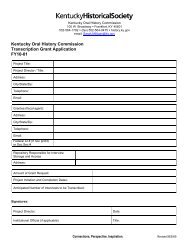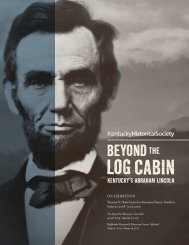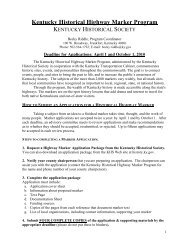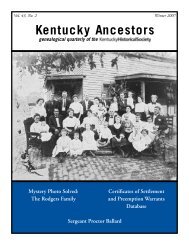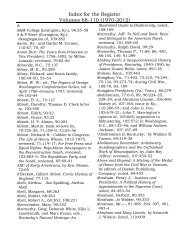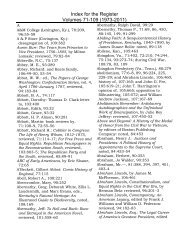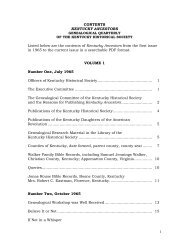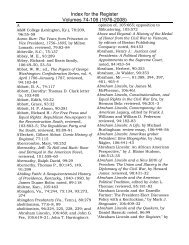PIONEER CEMETERY PROGRAM - Kentucky Historical Society
PIONEER CEMETERY PROGRAM - Kentucky Historical Society
PIONEER CEMETERY PROGRAM - Kentucky Historical Society
Create successful ePaper yourself
Turn your PDF publications into a flip-book with our unique Google optimized e-Paper software.
THE STEELE-REESE FOUNDATION<br />
<strong>PIONEER</strong> <strong>CEMETERY</strong> <strong>PROGRAM</strong>
<strong>PIONEER</strong> <strong>CEMETERY</strong> <strong>PROGRAM</strong><br />
Contents<br />
2 Criteria for Pioneer Cemetery designation<br />
3 Application for designation as a Pioneer Cemetery<br />
5 <strong>Historical</strong> Marker purchase document<br />
7 Accompanying documentation requirements<br />
8 Tips for mapping a cemetery<br />
10 Quadrant mapping<br />
14 <strong>Kentucky</strong> cemetery laws<br />
19 Appendix A: Standards for cemetery maintenance<br />
21 Appendix B: Cleaning old gravestones<br />
23 Appendix C: Deed indicating inclusion of a cemetery<br />
24 Appendix D: Description of the <strong>Kentucky</strong> <strong>Historical</strong> <strong>Society</strong>’s Cemetery<br />
Preservation Program<br />
25 Appendix E: Media tips<br />
26 Special Acknowledgements
Criteria for Designation as a Pioneer Cemetery<br />
The <strong>Kentucky</strong> <strong>Historical</strong> <strong>Society</strong>’s Pioneer Cemetery Program is established in order for families to<br />
document, preserve, restore and maintain their family cemetery which marks the resting place of the<br />
pioneers of their family and pioneers of the community in which they lived.<br />
Designation of a cemetery as a “Pioneer Cemetery” will help bring recognition to the cemetery as well as<br />
recognition to the descendants who have lovingly attempted to restore the dignity and respect that was<br />
given to their family members when they died and were buried in the family cemetery.<br />
Cemeteries designated as a “Pioneer Cemetery” are the keepers of stories and the history of those who<br />
decided to settle in a particular community. Community leaders and residents should take a keen interest<br />
in the resting places of those who were the first ones to call an area home and thus began the settlement<br />
that evolved into the communities they enjoy today.<br />
In order for a family cemetery to be designated as a <strong>Kentucky</strong> <strong>Historical</strong> <strong>Society</strong> Pioneer Cemetery, the<br />
following criteria must be met and documented:<br />
(1) The cemetery was established and receiving burials by 1842. (Documented by photographs of<br />
the pre-1842 grave marker or other historical documentation)<br />
(2) The boundaries of the cemetery can be documented<br />
(3) The graves of individuals who were living in <strong>Kentucky</strong> prior to 1800.<br />
(4) A cemetery for which over 10% of the existing gravestones are for individuals who died<br />
prior to 1850.<br />
(5) For a large municipal cemetery only that portion that contains graves with dates prior to<br />
1842 and 10% of existing gravestones of individuals who died prior to 1850 will be<br />
considered and designated as a <strong>Kentucky</strong> Pioneer Cemetery.<br />
(6) The cemetery has been cared for and cleaned of debris.<br />
(7) The cemetery has been mapped, according to accepted methods of mapping (see “Tips for<br />
Mapping a Cemetery” and an example of quadrant mapping included here.)<br />
(8) The cemetery is registered with the <strong>Kentucky</strong> <strong>Historical</strong> <strong>Society</strong>’s Cemetery Preservation<br />
Program. Cemeteries accepted as a Pioneer Cemetery will become a part of KHS’s inclusive<br />
Registry of <strong>Kentucky</strong>’s Pioneer Cemeteries.<br />
(9) The cemetery is marked with a <strong>Kentucky</strong> <strong>Historical</strong> <strong>Society</strong>’s Pioneer Cemetery Marker<br />
designating the cemetery as a <strong>Kentucky</strong> <strong>Historical</strong> <strong>Society</strong> Pioneer Cemetery (optional.)<br />
(10) Documentation of the GPS coordinates for this cemetery.<br />
Cemeteries accepted as a Pioneer Cemetery will become part of KHS’s Registry of <strong>Kentucky</strong> Pioneer<br />
Cemeteries. In addition, the cemetery will be marked with a special KHS Pioneer Cemetery Marker, with<br />
the cost of the marker to be paid by the applicant.<br />
To enroll a cemetery in the program, fill out the application form and marker purchase form. Be sure to<br />
include the accompanying documentation requirements (pg. 7).<br />
2
Pioneer Cemetery Designation Application<br />
Return form to:<br />
Pioneer Cemetery Preservation Program<br />
100 West Broadway, Frankfort, KY 40601<br />
Phone: 502-564-1792, Fax: 502-564-4701<br />
KHScemeteries@ky.gov<br />
The <strong>Kentucky</strong> <strong>Historical</strong> <strong>Society</strong> is maintaining a database of all cemeteries and burial sites in the<br />
state to provide a permanent record for preservation and educational purposes. In accompaniment<br />
to this database, the <strong>Society</strong> is implementing the <strong>Kentucky</strong> Pioneer Cemetery Program which will<br />
allow persons to designate a family cemetery as a Pioneer Cemetery. Such designation requires that:<br />
(1) The cemetery be established and receiving burials by 1842 (photographs, pre-1842 grave marker<br />
or historical documentation); (2) Cemetery boundaries can be identified; (3) The cemetery includes<br />
graves of individuals who were living in <strong>Kentucky</strong> prior to 1800; (4) A cemetery for which more than<br />
10% of the existing gravestones have a death date prior to 1850.<br />
Please complete all information that you know; write “Unsure” for any question for which you cannot obtain the answer.<br />
Name of cemetery:<br />
Current date:<br />
Location of cemetery (address):<br />
County:<br />
GPS location of the cemetery:<br />
Owner of the cemetery:<br />
Is the cemetery still in use (active burials)?<br />
Please list the boundaries of this cemetery (Eg. 40 feet by 50 feet):<br />
Describe how to get to this cemetery:<br />
Total number of acres in cemetery:<br />
Approximate number of existing tombstones:_______<br />
Type of Owner:<br />
Religious group<br />
Private family burial ground<br />
Non-profit organization<br />
Sole proprietorship<br />
Corporate<br />
Other<br />
How will maintenance be provided?<br />
Community or nonprofit organization<br />
Cemetery organization, board or committee<br />
Church group<br />
Volunteers<br />
Government<br />
Other:_______________________________<br />
Fieldstones? __Y __N<br />
How many?_________<br />
Number of other burial structures (Mausoleums, etc.):<br />
_______________<br />
Are there areas where graves are unmarked? ___Y___N<br />
Are there slave graves? ___Y___N<br />
How would you rate the current condition of cemetery or burial<br />
site?<br />
Well maintained and cared for<br />
Adequately maintained<br />
Needs maintenance<br />
Neglected<br />
Abandoned<br />
(Last contact person and phone number __________________<br />
__________________)<br />
3
Have arrangements been made for perpetual care and maintenance expenses of the cemetery, i.e. trust fund, nonprofit friends<br />
group, etc.? No______ Yes_____ Explain.<br />
HISTORICAL INFORMATION – Continue on additional sheets if necessary<br />
Earliest death date recorded (must be at least by the year Latest death date recorded:<br />
1842):<br />
Please list any particularly culturally or historically significant gravesites or other facts concerning this cemetery that would aid in<br />
designating this as a Pioneer Cemetery. Please use additional paper to list the names of those buried here prior to 1842.<br />
Notes: Include any additional information that you would like to provide about this cemetery such as religious affiliation, major<br />
period of use, relationship of the cemetery to the community or original family owner, etc.<br />
Bibliography and/or references: List all resources that can provide information on this cemetery including books, photographs,<br />
records, maps and personal interviews. Continue on additional sheet if necessary.<br />
Map: Please provide a map of the cemetery showing its location in relation to nearest cross streets and/or major natural features<br />
(rivers, etc.). Note any buildings adjacent to the cemetery. If necessary, map the cemetery in quadrants.<br />
Please use “Tips for Mapping a Cemetery” for assistance (Page ____) Also attached, please see samples of quadrant mapping<br />
(Page____.)<br />
Name and address of person completing this designation<br />
application:<br />
Phone number:<br />
Email address:<br />
KHS use only:<br />
Date Approved_______________<br />
Registry Number______________<br />
4
<strong>Kentucky</strong> Pioneer Cemetery<br />
<strong>Historical</strong> Marker<br />
Cemeteries that have been enrolled in the KHS Pioneer Cemetery Program will be marked with a<br />
special historical marker that designates the site as a <strong>Kentucky</strong> Pioneer Cemetery.<br />
The markers are purchased through the <strong>Kentucky</strong> <strong>Historical</strong> <strong>Society</strong>. Please contact KHScemeteries@<br />
ky.gov for information about the purchase price for each marker.<br />
An unveiling and dedication ceremony will be held at the time the marker is placed. Markers are only<br />
available for those cemeteries that have been documented as being a <strong>Kentucky</strong> Pioneer Cemetery<br />
and designated as such by the <strong>Kentucky</strong> <strong>Historical</strong> <strong>Society</strong>.<br />
To purchase a marker please complete the following purchase requisition and submit it with the<br />
appropriate reimbursement to:<br />
Pioneer Cemetery Preservation Program<br />
<strong>Kentucky</strong> <strong>Historical</strong> <strong>Society</strong><br />
100 West Broadway<br />
Frankfort, KY 40601<br />
Phone: 502-564-1792, Fax: 502-564-4701<br />
KHScemeteries@ky.gov<br />
You will be notified when the marker has been completed. We will, at that time, make arrangements<br />
with the contact person for the dedication ceremony and unveiling of the marker.<br />
5
KHS Pioneer Cemetery Program<br />
Cemetery Marker Requisition Form<br />
Cemetery name<br />
Address City Zip<br />
Registration number<br />
Pioneer Cemetery contact person(s)<br />
Address City Zip<br />
Phone number<br />
Fax number<br />
Email address<br />
Signature of person(s) purchasing marker<br />
Organization’s Federal ID Number (if applicable)<br />
NOTE: If an organization is purchasing a marker and the organization has 501(c) (3) non-profit<br />
status, please include a copy of your letter from the IRS with this requisition.<br />
Please include the appropriate payment with this requisition and mail to:<br />
<strong>Kentucky</strong> <strong>Historical</strong> <strong>Society</strong><br />
Pioneer Cemetery Program<br />
100 West Broadway<br />
Frankfort, <strong>Kentucky</strong> 40601<br />
6
KHS Pioneer Cemetery Program<br />
Documentation Requirements<br />
To join the KHS Pioneer Cemetery Program, complete the designation application form and include<br />
the following additional documentation. Send these items, the Cemetery Marker Requisition Form and<br />
payment for the marker to:<br />
<strong>Kentucky</strong> <strong>Historical</strong> <strong>Society</strong><br />
Pioneer Cemetery Program<br />
100 West Broadway<br />
Frankfort, <strong>Kentucky</strong> 40601<br />
Additional Documentation<br />
(1) Photographs attached indicating the cemetery was established and receiving burials by 1842.<br />
Photographs must be of clear quality, be labeled and be attached. Photographs on a disk<br />
are preferred.<br />
(2) Documentation of the boundaries of the cemetery.<br />
(3) Listing of graves of those living in <strong>Kentucky</strong> prior to 1800.<br />
(4) List the number of gravestones of individuals who died prior to 1850. (NOTE: Must be 10%<br />
of total number of gravestones.)<br />
(5) For a large municipal cemetery only that portion that contains graves with dates prior to<br />
1842 and 10% of existing gravestones of individuals who died prior to 1850 will be<br />
considered and designated as a <strong>Kentucky</strong> Pioneer Cemetery.<br />
(6) Documentation (photographs, etc.) indicating the cemetery has been cared for and cleaned<br />
of debris. Photographs must be of clear quality, be labeled and be attached. Photographs on<br />
a disk are preferred.<br />
(7) The cemetery has been mapped. (Enclose copy)<br />
(8) ]The cemetery is registered with the <strong>Kentucky</strong> <strong>Historical</strong> <strong>Society</strong>’s Cemetery Preservation<br />
Program’s database.<br />
(9) Documentation whether or not this cemetery will be marked with a <strong>Kentucky</strong> <strong>Historical</strong><br />
<strong>Society</strong>’s Pioneer Cemetery Marker. (optional)<br />
(10) GPS Location<br />
7
TIPS FOR MAPPING A <strong>CEMETERY</strong><br />
Below are some procedures to use when you map a cemetery. These are items to try to include on every<br />
map, so that future generations will be able to locate these cemeteries.<br />
1. If you are not familiar with the area, you may need to find the cemetery. If locals are not<br />
familiar with the name or location of the cemetery, other sources include:<br />
• City hall (City clerk or police department)<br />
• County court house (County clerk)<br />
• Mortuaries<br />
• Ministers<br />
• Libraries<br />
• Genealogical societies or research centers<br />
• Newspaper office<br />
• Chamber of commerce<br />
• <strong>Historical</strong> societies<br />
• County road department<br />
2. While you are at these sites, be sure to ask if there is a cemetery map available that you can<br />
copy. Sometimes the city has a copy; sometimes the mortuary provides them; sometimes a<br />
map is included in a genealogical publication. If only a large version is available, make a<br />
rough sketch of the layout before going to the cemetery. You can add landmarks and<br />
tombstone markings on site.<br />
3. It is good to ask for the locations of gravesites of people you know are buried there. The<br />
people who might have these locations include:<br />
• City clerks for small town cemeteries with no on-site caretaker<br />
• Cemetery sextons or on-site caretakers<br />
• Mortuaries - in many states the mortuary records are not private and include this data<br />
• Genealogical publications - with luck, the book will include names and site of burial<br />
4. Once you have gathered all of the information you can about the cemetery, you can visit the<br />
site. Mark the location of the cemetery using the site’s GPS coordinates.<br />
5. If you have a map of the cemetery, check your orientation and make sure you know where<br />
you want to go. Mark the names of the streets that border the cemetery and mark north,<br />
south, east and west on the map, if known.<br />
If you do not have a map, now is when you want to sketch one. Set the general outline of<br />
the whole cemetery. Then line in the main road or circle. Next mark minor roads. This will<br />
help define the sections of the cemetery. You can also include other major landmarks,<br />
including:<br />
*Chapels or mausoleums<br />
*Creeks or lakes<br />
*Bell towers<br />
*Office or work sheds<br />
*Flag poles<br />
*Large, singular items - like statues<br />
8
6. If you don’t have a map, now is when you want to start sketching one. Set the general<br />
outline of the whole cemetery and mark North, South, East and West on the map.<br />
Find the burial locations. Once you know where people are buried, look for other landmarks<br />
near the burial site that you can place on the map. Look for trees, streams or permanent<br />
landmarks to help narrow down the location. Make a drawing of each stone and grave;<br />
include the name, dates of birth and death (if possible) and the epitaph if there is one. If<br />
there is no stone, but it is obvious a grave is present (sunken earth, only a foot marker, etc.)<br />
indicate “unmarked: on the map. Draw the stones facing the compass direction in which<br />
they lie. NOTE: Early Christian burials placed the body facing east. If the stones are facing in a<br />
different direction, draw them facing that direction. If the grave is marked with a field<br />
stone, do not remove the stone, but indicate with an “X” on your map. Indicate at the<br />
bottom foot note what the “X” represents. Repeat this process for all the graves in your<br />
cemetery. If the cemetery is too large for a single map, divide the cemetery in quadrants and<br />
make the map for each quadrant following the directions above for a single cemetery.<br />
7. Be sure to take grass clippers and a brush. Some of these cemeteries do not get mowed<br />
often, or well. This will allow you to trim grass away from the stones in order to more easily<br />
read names or photograph the stones.<br />
8. When photographing, get in close and get a FULL shot of the headstone. The dates need to<br />
be larger and clearer for scanning purposes.<br />
On older white stones, you may need to photograph from an angle to try and get a shadow<br />
on the names. Also, be sure to keep your shadow out of the picture. On flat stones, you can<br />
always photograph from the back side, upside-down, to prevent a shadow. On upright<br />
stones, get low so the sun is over your shoulder or move to the side slightly. Using a mirror to<br />
reflect the sun onto the stone will help illuminate the carving for better reading.<br />
9. One of the most important documentations of a cemetery is its GPS (Global Positioning<br />
Satellite) location. Many hand-held devices, including smartphones, have GPS capabilities and<br />
should be used (when available) for complete documentation of the location of the cemetery.<br />
10. When you finish locating all of the names on your list, recheck your map. Drive through the<br />
cemetery and check the roads and landmarks. Make any final corrections and additions.<br />
11. Have images saved to a CD-ROM or USB flash drive. The images can then be sent to anyone<br />
as an attachment to an email from the CD-ROM or external drive. The images will be clearer<br />
for use on a website because they will not have to be scanned. Plus, it is always important to<br />
backup images.<br />
9
QUADRANT MAPPING<br />
10
KENTUCKY <strong>CEMETERY</strong> LAWS<br />
14
Appendix A<br />
STANDARDS FOR<br />
<strong>CEMETERY</strong> MAINTENANCE<br />
Before undertaking any cemetery preservation efforts, take the time to determine what preservation<br />
work is needed, the best way it can be done, and what minimum maintenance efforts will be needed.<br />
Establish preservation priorities, including top priorities and others that can be relegated to a less-urgent<br />
or second-stage status.<br />
This planning need not be relegated to professionals. In most cases the initial plan can be effectively<br />
developed by those who are most involved with (and most intimately concerned about) the welfare of<br />
the cemetery.<br />
The following points are provided as a reference for those considering preserving a cemetery. This<br />
includes the ongoing maintenance of the property once initial preservation work is completed. Longterm<br />
maintenance must be carefully considered in order to prevent the deterioration of the cemetery<br />
once the preservation crew has departed.<br />
1 Good maintenance does not necessarily imply a manicured appearance. Indeed, an older<br />
cemetery’s atmosphere may be enhanced by a relaxed but controlled growth of wildflowers<br />
and grasses.<br />
2 If close mowing and trimming is needed, be sure to avoid damaging the stones. Use nylon<br />
“weed-eaters” for close trimming. A blade guard on the mower protects not only the marker<br />
from sticks and rocks thrown by the mower, but it protects the individual(s) as well. Never use<br />
a rider mower or other large lawnmowers.<br />
3 Grass around soft stones (soapstone) or any unstable stone should only be trimmed by hand.<br />
4 Herbicides near stones should not be used. Fertilizers should only be used sparingly.<br />
5 Remember: trees and shrubs can be replaced; old stones cannot. Dense foliage can keep<br />
stones, particularly sandstone, damp enough to accelerate deterioration. A rule of thumb to<br />
follow is this: when in doubt, remove the foliage. There are exceptions, of course, and one<br />
might consider moving a stone rather than a 500-year-old live oak, for example.<br />
6 Do not capriciously move stones from their original sites. Their original location is historically<br />
significant. Once a stone is moved, it no longer becomes a grave marker, because it no longer<br />
marks a grave. It does, however, become a memorial marker. A moved stone alters the<br />
historic graveyard.<br />
7 Plant small, close-lying clovers and groundcovers near stones and in other hard-to-mow areas.<br />
8 Remove scrub trees and prune shrubs to prevent damage to stones.<br />
19
9 Do not move stones capriciously (to make straight rows for easier mowing, to create paths or<br />
to “correct” a stone’s facing orientation).<br />
10 Educate yourself and volunteers regarding procedures for historic graveyard care.<br />
11 Do not clean stones often. Do not clean stones more often than once every several years<br />
or longer.<br />
12 It is advisable to visit the cemetery during the periods of the year when most new growth<br />
of trees, shrubs and foliage will appear. At that time it can be determined whether or not<br />
limited or detailed maintenance efforts will need to be undertaken.<br />
Reference: “A Graveyard Preservation Primer” by Lynette Strangstad; published by American Association<br />
for State and Local History (AltaMira Press) in cooperation with Association for Gravestone Studies;<br />
AASLH, Nashville, TN 37201, 1988. Used with permission.<br />
20
Appendix B<br />
CLEANING OLD GRAVESTONES<br />
Be aware that serious damage can be done to stones by using improper cleaning methods. Even if<br />
they appear to be stable, not all stones can be safely cleaned. Unstable stones are those whose faces or<br />
lettering are flaking, or which have obvious fractures or a grainy surface which falls away easily. Stones in<br />
this condition should not be cleaned.<br />
STEPS: Test clean a small, inconspicuous area before tackling the whole stone. Treating this patch to the<br />
entire cleaning process will reveal any problems without affecting the whole stone, and will show the<br />
results that the complete cleaning will give.<br />
1. With a soft bristled brush, remove loose, dry materials.<br />
2. Wet stone thoroughly with clear water.<br />
3. Scrub with the soft brush and plain water. (Use brush with natural or plastic bristles, wire<br />
brushes will damage the stone).<br />
4. Clean stone beginning from the bottom up to avoid streaking.<br />
5. Make sure stone is wet before applying any cleaning solution. (Please refer to the<br />
recommended cleaning solutions included here. Try mildest cleaning solution first.<br />
6. After using any cleaner, flood the stone again and scrub, using clean water. Do not let any<br />
cleaner dry on the stone before removing it.<br />
7. To clean details of lettering or design:<br />
(a) Granite or slate: Use a soft wooden stick (tongue depressor, ice cream stick, orange<br />
cuticle stick.) Never use a metal tool.<br />
(b) On softer, grainer stones (as with sandstone or limestone) be more careful. Use a soft<br />
toothbrush or cotton swab.<br />
8. Last, thoroughly rise stone with lots of clean water.<br />
PROCEDURES TO AVOID<br />
• Do not use acidic cleaners on marble or limestone.<br />
• Do not sandblast gravestones.<br />
• Do not use high-pressure spraying to clean gravestones.<br />
• Do not attempt to clean any stone that is unstable.<br />
• Do not attempt to clean stones without first receiving proper direction.<br />
• Never use wire brushes or any metal instrument in cleaning stone.<br />
• Do not substitute household cleaners for those listed here.<br />
• Do not clean stones often. Even the most carefully cleaned stone looses stone particles with<br />
each cleaning.<br />
• Do not plan to clean stones more often than once every several years or longer.<br />
• Do not treat stones with “protective” coatings that are impermeable to water vapor. Such<br />
coatings can actually be very harmful to stones in years to come, and others are ineffective.<br />
TOOLS FOR STONE CLEANING<br />
• Goggles<br />
• Rubber gloves<br />
• Tampico (natural bristle) or plastic scrub brushes<br />
• Toothbrushes<br />
• Smooth wooden sticks such as ice cream sticks, tongue depressors, orange cuticle sticks<br />
21
• Q-tips<br />
• Spray bottle<br />
• Water source (a hose is great, but clean, gallon milk jugs work too)<br />
RECOMMENDED CLEANING SOLUTIONS<br />
(Listed in order of increasing strength)<br />
NOTE: Always use the weakest cleaning agent that cleans the stone effectively. Do not increase<br />
the recommended strength of a given solution. Use only those solutions recommended for the<br />
type of stone being cleaned.<br />
Marble and limestone<br />
• Water only<br />
• Non-Ionic detergent, such as Photo-Flo (available from photographic supply houses)<br />
• Triton-X 100 (available from conservator’s supply houses) and water. Use 1 ounce for every 5<br />
gallons of water.<br />
• Vulpex soap appropriate for stone cleaning (available from conservator’s supply houses) and<br />
water. Use 1 ounce for every 5 gallons of water.<br />
• Household ammonia. Use 1 cup for every 1 gallon of water.<br />
• Calcium hypochlorite. Use only to remove biological growth. Available as HTH and other<br />
swimming pool disinfectants. Use 1 Pound dry for every 4 gallons of water. Must be dissolved<br />
in warm water.<br />
Soapstone<br />
• Water only<br />
Slate<br />
• Water only.<br />
• Non-ionic detergent and water (see marble)<br />
Sandstone<br />
• Water only<br />
• Non-ionic detergent and water (see marble)<br />
Reference: “A Graveyard Preservation Primer” by Lynette Strangstad; published by American<br />
Association for State and Local History, in cooperation with Association for Gravestone Studies;<br />
AASLH, Nashville, TN, 1988, pp 60-63.<br />
NEVER USE:<br />
• Wire brushes, metal instruments, abrasive pads (Brillo pads, steel wool)<br />
• Acid or acidic cleaners (especially on marble or limestone!). These types of cleaners should<br />
ONLY be used by conservators with proper training on non-calcareous stone (limestone and<br />
marble are calcareous).<br />
• Household cleaners: soap (Ivory), detergents (liquid or powder), granular cleaners, bleach,<br />
commercial surface cleaners in spray bottles, or any other abrasive cleaner.<br />
• Never use a power sprayer to clean the stones.<br />
Remember: Make sure the stone is stable before attempting to clean it!<br />
22
Appendix C<br />
COPY OF DEED INCLUSION<br />
In order to ensure the preservation of your pioneer cemetery, it is important for the cemetery to be<br />
listed on the site’s property deed.<br />
When working with the cemetery, first check and see if the property is located on the current (most<br />
recent) property deed. Then, work your way backwards to find the earliest reference to the cemetery<br />
being noted on the deed. Researching deed books can be a daunting task. Early records of deeds may<br />
not exist or deeds that are recorded may not be easy to read. However, it is important to determine if<br />
the cemetery is listed on the deed. This will ensure that landowners and potential site developers are<br />
aware that a cemetery is located on the property.<br />
Although you are looking for the cemetery to be mentioned on the deed, it is also important to<br />
discover if the cemetery and its dimensions are specifically excluded from the deed. If the cemetery<br />
is specifically excluded, it means that the area that encompasses the cemetery is not owned by the<br />
person who owns the overall property. If, however, there is no mention of the cemetery on the deed<br />
and if there is no mention of the cemetery being excluded from the deed, then the ownership of the<br />
land that encompasses the cemetery goes with the purchase of the property.<br />
It is important for a cemetery (located in an area not protected by perpetual care) to be listed on<br />
the most current property deed. Many times, but not always, when land is designated for possible<br />
development and a deed search is done, every deed associated with the particular piece of property<br />
is not searched. In other words, only the current deed and possibly the prior three or four may be<br />
researched. If the cemetery had been listed as being on the property on the first deed and not<br />
brought forward, no mention of it will be found by those who only research the most current deeds.<br />
If this situation presents itself and there is no mention of a known cemetery on the current deed, it<br />
is advisable to seek legal advice to see what steps can be taken to have the cemetery included on the<br />
current deed. Seek the advice of an attorney who is well-versed in property law.<br />
23
Appendix D<br />
KENTUCKY <strong>CEMETERY</strong> PRESERVATION <strong>PROGRAM</strong><br />
A Service of the <strong>Kentucky</strong> <strong>Historical</strong> <strong>Society</strong><br />
Contact:<br />
<strong>Kentucky</strong> <strong>Historical</strong> <strong>Society</strong><br />
100 West Broadway, Frankfort, KY 40601<br />
Phone: 502-564-1792<br />
Fax: 502-564-4701<br />
Email: KHScemeteries@ky.gov<br />
AN OVERVIEW OF THE KENTUCKY <strong>CEMETERY</strong> PRESERVATION <strong>PROGRAM</strong><br />
Cemeteries are important historical assets that tell about a community’s past. They hold valuable<br />
resources for historical and genealogical research. More importantly, they are monuments to the<br />
people who once inhabited our communities. Across the Commonwealth, the <strong>Kentucky</strong> <strong>Historical</strong><br />
<strong>Society</strong> provides support to communities to assist with the preservation and care of cemeteries and<br />
gravestones. Through seminars that teach best practices in cemetery preservation and educational<br />
materials that provide guidance and instruction to local citizens, KHS partners with communities to<br />
preserve and promote this important part of the state’s history and heritage.<br />
Census of <strong>Kentucky</strong>’s Cemeteries<br />
The Cemetery Preservation Program is continuing the work begun by the <strong>Kentucky</strong> Attorney<br />
General’s Cemetery Task Force to develop a comprehensive survey of all cemeteries and burial sites<br />
in the state. Cities, counties, historical societies and other groups across the state are encouraged to<br />
work with us to develop a database that will list and provide a permanent record of all cemeteries<br />
and burial sites in the state. The database of surveys that was started by the Attorney General’s Office<br />
can be found via the <strong>Kentucky</strong> <strong>Historical</strong> <strong>Society</strong>’s website, www.history.ky.gov.<br />
Cemetery Preservation and Education Project<br />
The program provides ongoing resources to <strong>Kentucky</strong>’s citizens and organizations that are involved<br />
in or interested in the protection and preservation of our historic cemeteries and gravesites. The<br />
program provides:<br />
• Educational materials about appropriate cleaning and repairing techniques for old<br />
gravestones.<br />
• Seminars and symposia that bring together professionals and interested individuals to discuss<br />
preservation issues and techniques as well as the historical and cultural significance of<br />
<strong>Kentucky</strong>’s cemeteries and gravesites.<br />
• Support for projects that highlight the educational and historical significance of our state’s<br />
cemeteries.<br />
• Advocacy across the state for the continued care and preservation of our historic cemeteries.<br />
24
Appendix E<br />
MEDIA TIPS<br />
PROMOTING <strong>CEMETERY</strong> PRESERVATION<br />
Contact: <strong>Kentucky</strong> <strong>Historical</strong> <strong>Society</strong><br />
100 West Broadway, Frankfort, KY 40601<br />
Phone: 502-564-1792 | Fax: 502-564-4701<br />
Email: KHScemeteries@ky.gov<br />
• Prepare some talking points and look for interesting story angles unique to your workshop<br />
or event. A lot of reporters look for human interest stories and personal experiences that are<br />
also newsworthy. When you can, tie your story to statewide or national history. Keep in mind<br />
what is going on with current local events and what else you might be competing with for<br />
media attention.<br />
• Do your research! Look for editors, reporters and local media personalities (in print, radio,<br />
television and online) that already cover topics related to history and cemetery preservation.<br />
Researching each reporter or media outlet’s audiences and programming to find the best fit<br />
will result in better coverage of your workshop. Most people listen to the radio on the way to<br />
and from work or at lunch, so look for stations with morning or afternoon shows that<br />
highlight local news and events and will reach a broad audience. From your research, prepare<br />
a contact list (names, phone numbers, email and postal mail addresses) of people that should<br />
receive your press release.<br />
• Write a press release. You can use a recent press release on the <strong>Kentucky</strong> <strong>Historical</strong> <strong>Society</strong>’s<br />
website and your talking points as references. Be sure to include your contact information<br />
(name, phone number and email address). Be concise, relevant and specific to your<br />
community. Editors receive hundreds of press releases each week, so be brief but interesting<br />
enough to attract notice. Double and triple-check for facts, spelling and grammar. Send it to<br />
your press contact list roughly two weeks before your workshop.<br />
• Follow up on the press release with a personal phone call or email to the people on your<br />
contact list. Use your talking points to pitch them your story. Remember that most journalists<br />
work on a deadline, so return phone calls and emails from them as soon as possible. Print and<br />
broadcast deadlines vary, but the best time to contact most reporters is in the morning.<br />
• Be available. Make sure that at least one person is available to the media for interviews and<br />
can speak passionately and eloquently about the importance of cemetery preservation in your<br />
community and in <strong>Kentucky</strong>. Journalists often take photos, video or sound recordings during<br />
an interview and may ask for additional photographs and information. When possible, have a<br />
selection of high-resolution photographs (with captions and photographer credit) already<br />
available of the interview subject, community members, historical images, people at work in<br />
the cemetery or interacting with each other, and anything else relating to your story.<br />
• Utilize community calendars. Most media will add your event to their calendar once they<br />
receive your press release, but again it’s a good idea to follow up with the editor. A lot of<br />
newspapers, radio stations, television stations and community groups allow you to submit<br />
event information online.<br />
• Always follow up with the journalist with a thank you! An email, phone call or hand-written<br />
note is appropriate.<br />
25
SPECIAL ACKNOWLEDGEMENTS<br />
STEELE-REESE FOUNDATION<br />
The Steele-Reese Foundation is a charitable trust committed to supporting rural communities and<br />
the nonprofit organizations that serve them in Idaho, Montana and Appalachian <strong>Kentucky</strong>. Since<br />
its inception, the Foundation has maintained a focus on the unique challenges of rural living and<br />
on helping people build healthy, successful and sustainable communities. With grant funds from<br />
the Steele-Reese Foundation, KHS has developed an array of workshops and programs to help<br />
Kentuckians preserve their cemeteries. The <strong>Kentucky</strong> Pioneer Cemetery Program could not have been<br />
implemented without the support of the Steele-Reese Foundation. The <strong>Kentucky</strong> <strong>Historical</strong> <strong>Society</strong><br />
thanks the Steele-Reese Foundation for their support.<br />
KENTUCKY HISTORICAL SOCIETY FOUNDATION<br />
The <strong>Kentucky</strong> <strong>Historical</strong> <strong>Society</strong> Foundation (KHSF) has long been a supporter of cemetery<br />
preservation. Much of the success of the KHS Cemetery Preservation Program can be attributed<br />
to their support. The KHSF was formed to further the educational and stewardship purposes of<br />
the <strong>Kentucky</strong> <strong>Historical</strong> <strong>Society</strong> by providing assistance and support to the <strong>Society</strong> as needed.<br />
Consequently, the Foundation partners with the KHS in fulfilling its mission for engaging people in<br />
the exploration of the Commonwealth of <strong>Kentucky</strong>’s diverse heritage. Through comprehensive and<br />
innovative services, interpretive programs and stewardship, the <strong>Kentucky</strong> <strong>Historical</strong> <strong>Society</strong> and the<br />
KHS Foundation provide connections to the past, perspective on the present and inspiration for the<br />
future.<br />
THE STEELE-REESE FOUNDATION<br />
26





